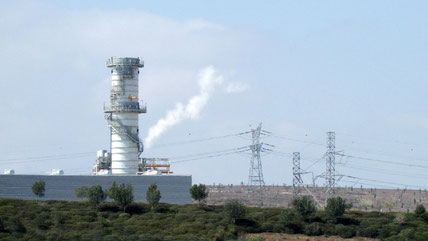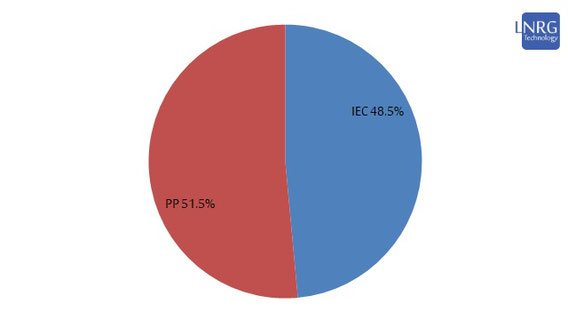
This report overviews the 2022-23 developments in the Israeli electricity market with emphasis on the power generation segment. A significant progress continued in 2022 in renewables led by the solar segment, but slowed down substantially towards the end of the year and in early 2023. In terms of conventional generation, the market mainly followed the implications of the Electricity Reform, gradually tansferring Natural Gas-powered generation towards the private segment and preparing to retire old coal units towards the end of 2023. By the end of 2022, Israeli national electric generation capacity stood at 21.7 GWp, with IEC making up 51.5% of total grid-connected capacity, while private producers made up the remaining 48.5%. In terms of electricity generation and supply in the Israeli market, 76.9 million kWh were produced in 2022, up from 74.0 million kWh in 2021. The 2022 generation segment was relying on a mix of fuels, dominated by natural gas and coal - both utilized by the Israel Electric Corp (IEC) as primary fuels. Secondary fuels of the IEC were diesel, oil fuel and methanol. Private power generation facilities were primary relying on natural gas, while diesel, oil fuel, kerogen and renewables were secondary energy sources. Notably, renewables reached the share of 9.8% of market supply in 2022 and is expected to reach 12.0% in 2023, primarily solar PV.
A significant progress continued in 2022 in renewables led by the solar segment, but slowed down substantially towards the end of the year and in 2023. About 1.1 GWp of renewable capacity was added in 2022, including some 900 MWp solar PV and inaugurating the largest Israeli wind power Emek Bakha project. In 2023, only 0.7 GWp is expected to go online, with dramatic decline of decentralized PV generation installations. By the end of 2022, Israeli national electric generation capacity stood at 21.7 GWp, with IEC making up 51.5% of total grid-connected capacity, while private producers made up the remaining 48.5%. The private generation sub-segment, including renewables, is hence approaching to one half share of the market and is expected to reach as much as 62.0% share by 2025.

From early 2000s and until early 2020s, the Israel Electric Corporation (IEC) had been denied from building new conventional power plants, thus practically all capacity additions during the period had been made by the private sector. Moreover, upon the Electricity Market Reform, the IEC was forced to sell several of its generation units, whilst enabling it to upgrade some of its units in the future. The IEC capacity further reduced upon retirement of several generation units in 2019 and privatization of three compounds in 2019 and 2020 respectively; another IEC site of Hagit completed the privatization process in December 2021, to be followed by Eshkol and then possibly Reding compound in mid 2020s. In 2023, the IEC completed the complementary Natural Gas-powered units 70 and 80 at the Orot Rabin site, aimed at replacing the retiring coal units 1-4. Unit 70 is the first to be synchronized with the grid in September 2023, while Unit 80 is expected in September 2024.
In terms of conventional generation, several power plants began continuous operation during 2022 and 2023 - most notably the 396 MWp Tzomet Energy power plant and the 630 MWp IEC Natural Gas generation Unit 70 at the Orot Rabin site; the Etgal Power Plants project is expected for connection and synchronization towards the end of 2023 but will probably be delayed into 2024. The Kokhav Yarden 344 MWp pump accumulation project is planned to be connected by the end of 2023 on top of the operating Gilboa plant. Among renewables, the major wind energy site of Emek Bakha underwent connection and synchronization in 2022 and Beresheet is expected towards the end of 2023; the 40 MWp solar Ashalim PV 2, 48 MWp Yachini PV, 82 MWp Sde Notzan and 246 MWp Teralight's Taanach 1 & 2 projects are all being connected during 2023. Hydropower capacity remained stable in 2022 and is not expected to change in 2023 beyond eight existing facilities. Furthermore, no small-scale biogas plants were added in 2022 on top of the fourteen exisiting and none are planned during 2023. Finally, in 2022, the first 5 MWp of PV-linked hybrid electricity storage was deployed and this number is due to grow substantially in 2023. Overall, some 60 utiliy-scale high-voltage power plants contributed to Israeli electricity generation correct for December 2022 and this is expected to grow to 65 by December 2023.

In terms of electricity market generation and supply, 74.0 million kWh were produced in 2021 and 76.9 million kWh in 2022, with about 77.5 million kWh expected to be generated in 2023. Through 2022, IEC produced 51.1% of electricity supply and added with electricity purchased from private producers, the IEC altogether controlled 69.3% of total electricity supply, whereas the remaining 30.7% consisted of output supplied by private producers directly to customers, power purchase agreements (PPAs) or schemes of self-consumption (small PV producers and four conventional power plants). Private generation share hence reached 48.9% during 2022 and is expected to continue rising through 2023 and onward to surpass 50%. This brings closer the electricity reform target of maximum 40% IEC generation, favoring the distribution of the electricity generation market segment in favor of IPPs and renewables, aimed altogether to surpass 60% of market generation output by 2025.
In 2022, the generation segment was relying on a mix of fuels, dominated by natural gas and coal - both utilized by the IEC as primary fuels. Secondary fuels of the IEC were diesel, oil fuel and methanol. Private generation facilities were primary relying on natural gas, while diesel, oil fuel and renewables were lesser energy sources. When combined, the electricity generation segment continued to be dominated by natural gas as the primary energy source (55.2% by capacity), with coal as the secondary source (22.3% by capacity) and third place taken by renewables (20.7% by capacity) – predominantly solar PV technology (18.7% by capacity), as well as smaller capacities of solar thermal (ST), wind, biogas and hydro. Pump accumulation accounted for 1.4% of capacity, while other fossil fuels contributed a tiny fraction of 0.4% total capacity. In 2023, renewables' share is expected to experience further growth, surpassing 20% of total capacity.

In the past, the Electricity Authority estimated that the growth in electricity demand during the second and third decades of the 21st century is to be at 2.7% annually, which is slightly above the demographic growth rate. In reality, the growth of electricity demand in Israel was at 4.3% in 2019, but in 2020 experienced flat growth due to the Covid19 crisis and slowly rebounded since, with +1.5% in 2021 and +3.8% in 2022. Supply and demand are hence expected to grow by 1.9% and 2.0% respectively in 2023. Though there is still a total electricity demand growth due to rapid demographic expansion of about 2.0% annual, the main element to support electricity demand growth in upcoming years is the expected wide-spread adoption of electric vehicles and other transportation (mostly light rail and heavy rail).

Grid supply per capita (excluding peer-to-peer deals) decreased from 6.4 thousand kWh in 2018 and 2019 to 6.2 thousand kWh annually in 2020, and further decreased to 6.0 thousand kWh in 2021 and 5.6 thousand kWh in 2022. The electricity demand per capita (excluding peer-to-peer deals) also decreased from 5.9 thousand kWh annual in 2018 and 2019 to 5.7 thousand kWh in 2020 and 5.5 thousand kWh annual per capita in 2021 and 5.1 thousand kWh in 2022. Total electricity generation per capita in Israel was 7.8 thousand kWh annual in 2018 and 8.0 thousand kWh annual in 2019, then decreasing to 7.9 thousand kWh annual in 2020 and 2021, and finally slightly increasing to 8.0 thousand kWh in 2022. The 2023 electricity generation supply and demand figures per capita are expected to show a minor decrease.

The transmission and distribution segments continued to be controlled by the IEC, but after the adoption of the Electricity Reform, the grid control department was split into a separate company named Noga in 2019 and received operation license in June 2020. Distribution segment has about 10% share licensed to the Kibbutzim and the rest controlled by IEC; more players are expected to enter this segment as virtual providers upon the implementation of the market reform. Notably, in 2021 it was announced that 18 players would enter the distribution segment under this framework and began operating in 2022. It increased to 24 players by early 2022 and to 33 players by mid 2022.
The off-grid electricity market in Israel is essentially small, estimated at only several dozen megawatts deployed in desolate locations, including diesel generators and solar PV collectors. There are four major off grid facilities for self-consumption - the Noble Energy Mediterranean 31.85 MVA offshore generation unit at the Tamar gas field, the Rotem Amfert 16.7 MWp generation unit, the Ben Gurion Airport 12.4 MWp facility and the Nesharim Energy 2014 facility rated 48.3 MWp.
The extended commercial report and premium member data page access can be purchased at the LNRG Technology digital store.
















